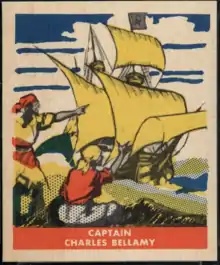Charles Bellamy | |
|---|---|
 Charles Bellamy card from the 1948 Leaf Pirate Trading Card set | |
| Nationality | English |
| Occupation | Pirate |
| Years active | 1717-20 |
| Piratical career | |
| Base of operations | New England |
Charles Bellamy (fl. 1717–1720) was an English pirate who raided colonial American shipping in New England and later off the coast of Canada. He is often confused with the more well-known Samuel "Black Sam" Bellamy, as they operated in the same areas at the same time.
History
Bellamy raided with a fleet of three ships off the New England and Canadian east coasts in summer 1717, ranging as far north as the Bay of Fundy.[1] Using slave labor he set up an encampment and a small fort (possibly at St. Andrew's), from which he attacked the fishing fleets off Newfoundland and Fortune Bay.[2] Thinking he'd found a large merchant vessel in the Gulf of St. Lawrence, he accidentally engaged a French 36-gun warship which heavily damaged his ship and forced him to flee after a three-hour battle.[2] Escaping at night under cover of a storm, he left to set up a new camp, either at Placentia[1] or Oderin.[2] After some years ashore he disappeared with his remaining loot.[1]
Confusion with Samuel Bellamy
Samuel “Black Sam” Bellamy was active from 1716 to 1717 and engaged in piracy in the Caribbean and as far north as Cape Cod. Captain Charles Johnson's[3] 1724 “General History of the Pyrates” contains a lengthy section on “Capt. Bellamy” including several speeches supposedly delivered to captured merchant captains.[4] The speeches and monologues - extolling pirate freedoms and haranguing the captains for serving greedy masters - are generally thought to be Johnson's literary inventions.[2] They were attributed by later writers to Charles Bellamy, along with the shipwreck which claimed Samuel Bellamy's life, and caused Philip Gosse to describe Charles Bellamy as “BELLAMY, Captain Charles. Pirate, Socialist, and orator. A famous West Indian filibuster.”[5] An example of the speeches attributed by Johnson to “Bellamy,” and by others to Charles Bellamy:
"I am sorry," he said, "that you can't have your sloop again, for I scorn to do anyone any mischief—when it is not to my advantage—though you are a sneaking puppy, and so are all those who will submit to be governed by laws which rich men have made for their own security, for the cowardly whelps have not the courage otherwise to defend what they get by their knavery. But damn ye altogether for a pack of crafty rascals, and you, who serve them, for a parcel of hen-hearted numbskulls! They vilify us, the scoundrels do, when there is the only difference that they rob the poor under cover of the law, forsooth, and we plunder the rich under the protection of our own courage. Had you not better make one of us than sneak after these villains for employment?"[5]
See also
- Stede Bonnet – another pirate captain whose deeds were conflated with Bellamy's by “Captain Charles Johnson”.[6]
References
- 1 2 3 Edwards, Peter; Auger, Michel (2012). The Encyclopedia of Canadian Organized Crime: From Captain Kidd to Mom Boucher. Toronto ON: McClelland & Stewart. p. 19. ISBN 9780771030499. Retrieved 12 October 2017.
- 1 2 3 4 Horwood, Harold (2011). Plunder & Pillage: Atlantic Canada's Brutal and Bloodthirsty Pirates and Privateers. Halifax NS: Formac Publishing Company Limited. pp. 92–96. ISBN 9780887809491. Retrieved 12 October 2017.
- ↑ A pseudonym, possibly for Daniel Defoe, Nathaniel Mist, or a contemporary.
- ↑ Johnson, Charles (1724). The history of the pyrates: containing the lives of Captain Mission. Captain Bowen. Captain Kidd ... and their several crews. London: T. Woodward. Retrieved 26 July 2017.
- 1 2 Gosse, Philip (1924). The Pirates' Who's Who by Philip Gosse. New York: Burt Franklin. Retrieved 23 June 2017.
- ↑ Brooks, Baylus C. (17 September 2016). "B.C. Brooks: A Writer's Hiding Place: Nathaniel Mist's Piracy!". B.C. Brooks. Retrieved 12 October 2017.
